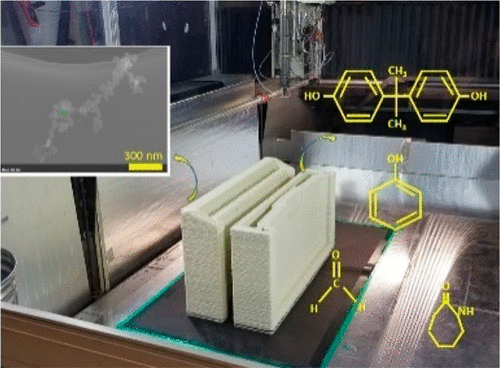当前位置:
X-MOL 学术
›
ACS Chem. Health Saf.
›
论文详情
Our official English website, www.x-mol.net, welcomes your feedback! (Note: you will need to create a separate account there.)
Large-Format Additive Manufacturing and Machining Using High-Melt-Temperature Polymers. Part II: Characterization of Particles and Gases
ACS Chemical Health & Safety Pub Date : 2021-03-25 , DOI: 10.1021/acs.chas.0c00129 Aleksandr B Stefaniak 1 , Lauren N Bowers 1 , Stephen B Martin 1 , Duane R Hammond 2 , Jason E Ham 1 , J R Wells 1 , Alyson R Fortner 1 , Alycia K Knepp 1 , Sonette du Preez 3 , Jack R Pretty 2 , Jennifer L Roberts 2 , Johan L du Plessis 3 , Austin Schmidt 4 , Matthew G Duling 1 , Andrew Bader 4 , M Abbas Virji 1
ACS Chemical Health & Safety Pub Date : 2021-03-25 , DOI: 10.1021/acs.chas.0c00129 Aleksandr B Stefaniak 1 , Lauren N Bowers 1 , Stephen B Martin 1 , Duane R Hammond 2 , Jason E Ham 1 , J R Wells 1 , Alyson R Fortner 1 , Alycia K Knepp 1 , Sonette du Preez 3 , Jack R Pretty 2 , Jennifer L Roberts 2 , Johan L du Plessis 3 , Austin Schmidt 4 , Matthew G Duling 1 , Andrew Bader 4 , M Abbas Virji 1
Affiliation

|
Extrusion of high-melt-temperature polymers on large-format additive manufacturing (LFAM) machines releases particles and gases, though there is no data describing their physical and chemical characteristics. Emissions from two LFAM machines were monitored during extrusion of acrylonitrile butadiene styrene (ABS) and polycarbonate (PC) polymers as well as high-melt-temperature Ultem (poly(ether imide)), polysulfone (PSU), poly(ether sulfone) (PESU), and polyphenylene sulfide (PPS) polymers. Filter samples of particles were collected for quantification of elements and bisphenol A and S (BPA, BPS) and visualization of morphology. Individual gases were quantified on substance-specific media. Aerosol sampling demonstrated that concentrations of elements were generally low for all polymers, with a maximum of 1.6 mg/m3 for iron during extrusion of Ultem. BPA, an endocrine disruptor, was released into air during extrusion of PC (range: 0.4 ± 0.1 to 21.3 ± 5.3 μg/m3). BPA and BPS (also an endocrine disruptor) were released into air during extrusion of PESU (BPA, 2.0–8.7 μg/m3; BPS, 0.03–0.07 μg/m3). Work surfaces and printed parts were contaminated with BPA (<8–587 ng/100 cm2) and BPS (<0.22–2.5 ng/100 cm2). Gas-phase sampling quantified low levels of respiratory irritants (phenol, SO2, toluene, xylenes), possible or known asthmagens (caprolactam, methyl methacrylate, 4-oxopentanal, styrene), and possible occupational carcinogens (benzene, formaldehyde, acetaldehyde) in air. Characteristics of particles and gases released by high-melt-temperature polymers during LFAM varied, which indicated the need for polymer-specific exposure and risk assessments. The presence of BPA and BPS on surfaces revealed a previously unrecognized source of dermal exposure for additive manufacturing workers using PC and PESU polymers.
中文翻译:

使用高熔点聚合物的大幅面增材制造和加工。第二部分:颗粒和气体的表征
在大幅面增材制造 (LFAM) 机器上挤出高温聚合物会释放颗粒和气体,尽管没有描述其物理和化学特性的数据。在丙烯腈丁二烯苯乙烯 (ABS) 和聚碳酸酯 (PC) 聚合物以及高温熔体 Ultem(聚(醚酰亚胺))、聚砜(PSU)、聚(醚砜)( PESU) 和聚苯硫醚 (PPS) 聚合物。收集颗粒的过滤样品用于元素和双酚 A 和 S(BPA、BPS)的量化和形态的可视化。在特定物质的介质上对单个气体进行量化。气溶胶取样表明,所有聚合物的元素浓度普遍较低,最高为 1.6 mg/m 3用于 Ultem 挤压过程中的铁。BPA 是一种内分泌干扰物,在 PC 挤出过程中释放到空气中(范围:0.4 ± 0.1 至 21.3 ± 5.3 μg/m 3)。在 PESU 挤出过程中,BPA 和 BPS(也是一种内分泌干扰物)释放到空气中(BPA,2.0–8.7 μg/m 3;BPS,0.03–0.07 μg/m 3)。工作表面和印刷部件被 BPA (<8–587 ng/100 cm 2 ) 和 BPS (<0.22–2.5 ng/100 cm 2 ) 污染。气相采样量化了低水平的呼吸道刺激物(苯酚、SO 2、甲苯、二甲苯)、可能或已知的哮喘原(己内酰胺、甲基丙烯酸甲酯、4-氧代戊醛、苯乙烯)和空气中可能的职业致癌物(苯、甲醛、乙醛)。LFAM 过程中高温聚合物释放的颗粒和气体的特性各不相同,这表明需要对聚合物进行特定的暴露和风险评估。表面上 BPA 和 BPS 的存在揭示了使用 PC 和 PESU 聚合物的增材制造工人以前无法识别的皮肤暴露来源。
更新日期:2021-03-25
中文翻译:

使用高熔点聚合物的大幅面增材制造和加工。第二部分:颗粒和气体的表征
在大幅面增材制造 (LFAM) 机器上挤出高温聚合物会释放颗粒和气体,尽管没有描述其物理和化学特性的数据。在丙烯腈丁二烯苯乙烯 (ABS) 和聚碳酸酯 (PC) 聚合物以及高温熔体 Ultem(聚(醚酰亚胺))、聚砜(PSU)、聚(醚砜)( PESU) 和聚苯硫醚 (PPS) 聚合物。收集颗粒的过滤样品用于元素和双酚 A 和 S(BPA、BPS)的量化和形态的可视化。在特定物质的介质上对单个气体进行量化。气溶胶取样表明,所有聚合物的元素浓度普遍较低,最高为 1.6 mg/m 3用于 Ultem 挤压过程中的铁。BPA 是一种内分泌干扰物,在 PC 挤出过程中释放到空气中(范围:0.4 ± 0.1 至 21.3 ± 5.3 μg/m 3)。在 PESU 挤出过程中,BPA 和 BPS(也是一种内分泌干扰物)释放到空气中(BPA,2.0–8.7 μg/m 3;BPS,0.03–0.07 μg/m 3)。工作表面和印刷部件被 BPA (<8–587 ng/100 cm 2 ) 和 BPS (<0.22–2.5 ng/100 cm 2 ) 污染。气相采样量化了低水平的呼吸道刺激物(苯酚、SO 2、甲苯、二甲苯)、可能或已知的哮喘原(己内酰胺、甲基丙烯酸甲酯、4-氧代戊醛、苯乙烯)和空气中可能的职业致癌物(苯、甲醛、乙醛)。LFAM 过程中高温聚合物释放的颗粒和气体的特性各不相同,这表明需要对聚合物进行特定的暴露和风险评估。表面上 BPA 和 BPS 的存在揭示了使用 PC 和 PESU 聚合物的增材制造工人以前无法识别的皮肤暴露来源。


























 京公网安备 11010802027423号
京公网安备 11010802027423号